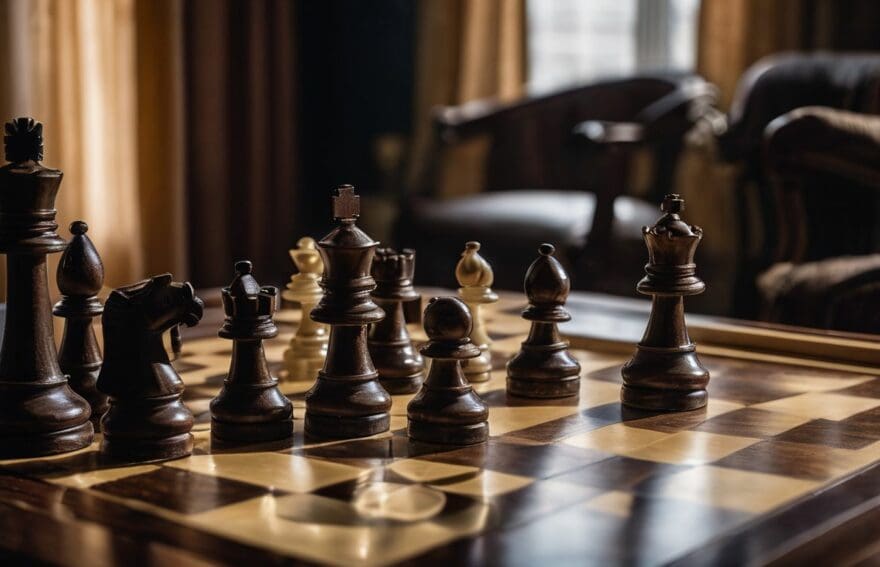The Psychology of Fighting Games: A Deep Dive into FGC Dynamics

Updated On: November 29, 2025 by James Connolly
Struggling to gain the upper hand in your favourite fighting games? You’re certainly not alone; we’ve all experienced the frustration of a well-executed combo sending our fighter to the canvas.
With no fewer than eight major “Street Fighter” tournaments taking place annually, it’s evident there’s a methodical approach needed to master these games. This is precisely where our assistance comes into play – our thorough exploration into the psychology that underpins every jab and uppercut will reveal strategies that could completely transform your gameplay.
Prepared for round one? Let’s get stuck in!
The Connection Between Flesh and Blood and Fighting Games
We can feel the adrenaline pump through our veins just like in a real fight when we’re locked in a virtual bout on screen. The physical tension is mirrored perfectly as our fingers dance over buttons, executing complex combos and strategic plays that mimic the cut-and-thrust of hand-to-hand combat.
This tangible exchange between player skill and character action forms the heart of fighting games’ appeal.
In these intense matches, we engage with an underlying card economy and manage fatigue as if stepping into the arena ourselves. We read opponents, anticipate moves, and adapt tactics constantly—mental manoeuvres that echo the psychological warfare found in traditional martial arts clashes.
Recognising patterns and exploiting weaknesses demands a level of cognitive psychology akin to chess but played out at breakneck speeds; it’s here where understanding this connection deepens our mastery—and enjoyment—of each encounter within the game’s combative world.
The Power of Player/Character Identity in Fighting Games
Unique characters in fighting games add depth to the gaming experience, allowing players to build a strong connection with their chosen character. This bond can influence gameplay and strategy, making character selection a crucial aspect of competitive gaming dynamics.
Unique characters in the game
Each character in a fighting game brings its own set of unique abilities and playstyles, offering players a diverse range of options to choose from. Understanding the strengths and weaknesses of each character is essential for developing effective strategies and adapting to different opponents.
With no two heroes playing alike, players have the opportunity to explore various combat styles, allowing for creativity and personalisation in gameplay. Building a connection with a specific character can lead to a deep appreciation for their individual tools and mechanics, adding an immersive layer to the overall gaming experience.
Players also have the chance to discover characters that resonate with their preferred playstyle or personality traits. From swift martial artists to hulking bruisers, each character embodies distinct traits that cater to different player preferences, encouraging gamers to experiment with various combat approaches.
Building a connection with a character
As gamers, we immerse ourselves in the virtual world of fighting games, where selecting a character is more than just picking a name from a roster. The psychology behind building a connection with a character goes beyond aesthetics – it’s about finding a playstyle that resonates with us.
Each character embodies unique traits and abilities, catering to different strategies and preferences. Identifying with these traits allows players to channel their own strengths through their chosen character, creating an emotional bond that enhances the gaming experience.
Understanding the intricate dynamics of each character not only adds depth to our gameplay but also fosters a sense of attachment to our virtual alter egos. As we delve into mastering each move set and ability of our chosen fighter, we bridge the gap between player and pixelated hero, forming an unspoken alliance that fuels our passion for competitive play.
The Importance of Diverse Characters in Fighting Games
No two heroes play alike and understanding how FAB characters fit into fighting game archetypes is key for players to develop diverse strategies. This section will delve into the significance of character diversity in fighting games and its impact on gameplay dynamics.
No two heroes play alike
In fighting games, each character is unique, offering a distinct playstyle and set of abilities. This diversity allows players to find a hero that suits their preferred tactics and strategies, adding depth to the gameplay experience.
Understanding these differences between characters is essential in mastering the game’s mechanics and developing effective combat strategies. By exploring the individual tools and strengths of each hero, players can gain a deeper understanding of the game dynamics, providing them with an edge in competitive matches.
Furthermore, learning to adapt to different heroes’ playstyles provides valuable insight into anticipating opponents’ moves and adjusting strategies accordingly. The variety among heroes not only enriches the gaming experience but also fosters strategic thinking and adaptability within the playing community.
How FAB characters fit into fighting game archetypes
In fighting games, FAB characters fit into various archetypes that define their unique playstyles and abilities. Each character embodies a distinct approach to combat, offering players a diverse range of gameplay experiences.
Whether it’s the agile and nimble fighter, the heavy-hitting powerhouse, or the strategic grappler, FAB characters are designed to cater to different player preferences and strategies.
Understanding these archetypes is crucial for players looking to master the intricacies of each character and maximise their potential in battle.
The diversity of FAB characters adds depth and complexity to fighting game dynamics. By incorporating various archetypes, developers offer an array of options for players with different playstyles and preferences.
Players can explore the strengths and weaknesses of each archetype, allowing them to adapt their tactics based on their chosen character’s unique traits. This variety not only enhances replay value but also encourages players to delve deeper into understanding how FAB characters fit into specific fighting game archetypes.
The Role of Psychology in Fighting Games
Utilising mind games to outsmart opponents is a crucial aspect of fighting games, as well as developing strategies for reducing the need to constantly read opponents. These psychological tactics can give players an edge in the heat of battle.
Using mind games to outsmart opponents
Mastering the art of mind games is a crucial skill in fighting games. By anticipating our opponent’s moves and understanding their patterns, we can outsmart them and gain the upper hand.
Reading their tendencies and responding with strategic gameplay can throw them off balance, allowing us to control the flow of the match. Our ability to anticipate their next move gives us an advantage in dictating the pace of play, forcing them to react to our strategy.
Strategies for reducing the need to read opponents include honing our own unpredictable tactics while keeping a calm mindset. By maintaining composure and not being easily swayed by our opponent’s actions, we can create uncertainty and put pressure on them instead.
Strategies for reducing the need to read opponents
- Efficient use of character tools: Leveraging a character’s unique abilities or moveset can create situations where opponents have fewer opportunities to exploit patterns.
- Creating ambiguous situations: By mixing up offensive and defensive tactics, players can make it harder for opponents to predict their next move.
- Consistent pressure: Applying consistent pressure on opponents forces them to react rather than allowing them time to plan and execute elaborate strategies.
- Adapting playstyles: Being able to quickly adapt and change tactics in response to an opponent’s behaviour can disrupt their game plan.
- Mental conditioning: By conditioning opponents into making certain responses, players can manipulate their decisions during crucial moments of a match.
- Utilising feints and baits: Misleading opponents with feints and baits can lead them into vulnerable positions that allow for punishing counterattacks.
- Exploiting habits and tendencies: Observing opponent patterns and adapting one’s playstyle accordingly can reduce the need for constant readjustment during a match.
- Controlling space effectively: Strategic positioning within the game environment limits an opponent’s options, making it easier to predict their actions.
Overcoming Challenges in Fighting Games
– Overcoming challenges in fighting games requires strategic thinking and quick reflexes, as well as the ability to adapt to different play styles. This section will explore common myths and strategies for improving your fighting game skills.
The myth of ‘winmore’ cards
In fighting games, the myth of ‘winmore’ cards suggests that certain powerful moves or abilities only benefit players who are already winning. However, this concept overlooks the potential strategic advantage these tools offer.
By using ‘winmore’ cards effectively, a player can solidify their lead or turn the tide in their favour during close matches. It’s essential to recognise the value of these powerful assets and understand how they can be leveraged to maintain control or secure victory in intense situations.
Raising reaction game
To improve your gameplay and stay ahead of your opponents, you need to work on raising your reaction game. Here are some strategies to help you enhance your reaction time and decision-making skills:
- Focus on practising quick decision – making under pressure.
- Train your reflexes through specific exercises and drills.
- Work on developing a keen awareness of your opponent’s movements and patterns.
- Analyse and learn from your mistakes to improve your reaction time in future matches.
- Incorporate mindfulness techniques to stay calm and focused during intense fights.
- Experiment with different playstyles to adapt and react swiftly to various gaming situations.
- Stay updated with the latest gaming trends and strategies to keep your reaction game sharp.
Conclusion
In conclusion, the psychology of fighting games is a complex and fascinating aspect of the genre. Understanding player and character identity, diverse character selection, mind games, and strategies for reducing the need to read opponents are crucial elements.
Overcoming challenges such as the myth of ‘winmore’ cards and raising reaction game adds depth to the gaming experience. Mastering these intricacies can give players a competitive edge and enhance their enjoyment of fighting games.
FAQs
1. What is the role of psychology in fighting games?
Psychology in fighting games involves mental work like reading your opponent to guess their next move and choosing an optimal strategy based on FGC dynamics.
2. Why is character selection important in fighting games?
In combat games, choosing the right character with suitable tools can give players a strategic advantage by fitting their playstyle and countering opponents effectively.
3. How does fatigue affect gamers during long gaming sessions?
During extended periods of gaming, players may experience fatigue which can impact their cognitive abilities, making it harder to concentrate and make quick decisions.
4. Can understanding psychological strategies help in esports tournaments?
Yes! Learning about psychological aspects such as opponent reading, social dynamics, and player mentality gives competitors an edge in esports psychology and helps them perform better under pressure.
5. Are social dynamics a part of the fighting game community experience?
Absolutely! Social interactions play a big role within the video game culture, affecting how players engage with each other and influencing their experiences within the community.


